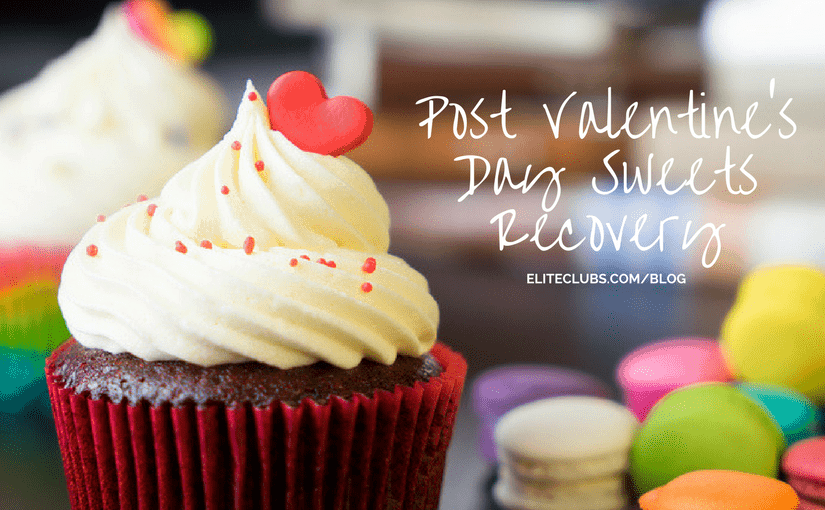
So you just ate a whole box of chocolates or sleeve of red velvet Oreos with your Valentine’s Day sweetie…now what?
I’m a sweets kinda gal. Just love em! And it can be a problem, particularly at specific times of the year…like when my kids were smaller and they brought home a huge plastic pumpkin filled with Halloween candy, or during the holidays when everyone starts sending you boxes of chocolates and parties abound. Ohhhh, the caramel filled chocolates…but I digress.
If you’re like me, you have trouble controlling how much you have, once you start to indulge. One cookie becomes 2 cookies becomes the whole sleeve of cookies. Then you’re thinking, “Oh man, how did I do that?!” And then the guilt sets in. And then maybe you grab the box of chocolates, because you’ve already ruined the day, what’s another 2000 calories? Wait…2000?! Ahhh, there is the problem. A serving size is never as much as you want to eat of the sweets, and once the addictive nature of sugar has you in it’s grasp, it won’t let go until you do a huge amount of damage.
So…now what?
4 ways to recover from an overindulgence of sweets:
“When you ingest any kind of carb or sweet, it breaks down into glucose,” said Lisa Eberly, RD. “That glucose runs through your veins in the hopes of being taken up into the cells and used for energy.”
Got it. Sugar becomes glucose, glucose is the body’s energy.
“This glucose — a fancy word for sugar — cruises through the blood until your muscle cells signal that they need some glucose to break down and use as energy.”
1. Move.
Hungry muscles want sugar! Use those muscles, and you’ll be using up some of that excess sugar. Um, ok, sounds like a great plan!
But if you’re not using your muscles (read: working out, moving, etc.) then that energy is actually going to turn into fat (well crap). “If you eat a ton of sugar and then lounge on the couch, your muscles are like, ‘Nah, no thanks.’ And that glucose mulls around a bit and ultimately gets stored as fat,” said Eberly. Oh no!
On the contrary, if you eat sugar and then go for a 10-minute walk, your muscles are like, ‘Hey dude, thanks for the fuel,’ and they soak that glucose up. This doesn’t mean you need to hit up a HIIT class right after eating three cupcakes, it just means that if your body is moving, you’re using glucose. Best practice would be a nice walk for 15 to 20 minutes to counteract a sugar binge.
And a reminder, there are WAY healthier ways to feed your muscles glucose — so don’t do this on purpose!
2. Water.
Literally, we are trying to “water down” the glucose in your system. Think about a cocktail with no ice. They can be pretty strong—also I think they want to make it look like there’s more in that glass than there really is, just sayin’. If you add ice, or seltzer, you water down the drink and make it less potent. Same deal with the sugar in your bloodstream. Water dilutes the sugar.
3. Time.
You feel that high coming from all of that sugar, but if you are like me, you also have some ill effects. You feel sluggish after that immediate rush. Does anyone else get “sweaters” on their teeth? Too much sugar makes a “coating” on my teeth that I just hate. And bad breath/bad taste in the mouth. Ugh! It’s just going to take some time. You have to let your system work it out. Employ steps 1 and 2, and you will be feeling a bit less of the ill effects, but it will still take time.
4. Don’t do it!
Having had that experience, learn from it, and try not to repeat it. Are there healthier snacks that you can keep in the house? Can you avoid buying the things that make you weak willed? How about making some alternative items that have a bit of a healthier profile, like home baked sweets with Stevia, coconut flour (high in protein), or almond flour?
Set up a Free Fitness Consultation
Written by Melissa Abramovich, ACE CPT, NASM CGT, AAHFRP Medical Exercise Specialist at Elite Sports Club-River Glen
Melissa Abramovich went into Personal Training and Group Exercise instruction after successfully losing 140 pounds through healthy diet and exercise. Her desire to help others drove her forward into a career helping others to make healthier choices. She is an ACE certified personal trainer and now also a Medical Exercise Specialist (AAHFRP), helping clients with a myriad of health issues at Elite Sports Clubs. She holds a Bachelor’s degree, and many group exercise related certifications as well.